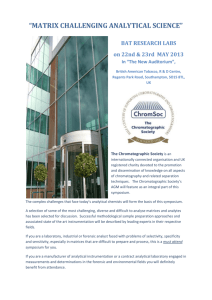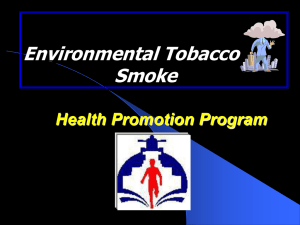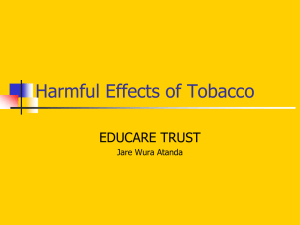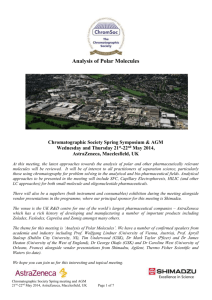BAT RESEARCH LABS ON 22nd & 23rd MAY 2013
advertisement
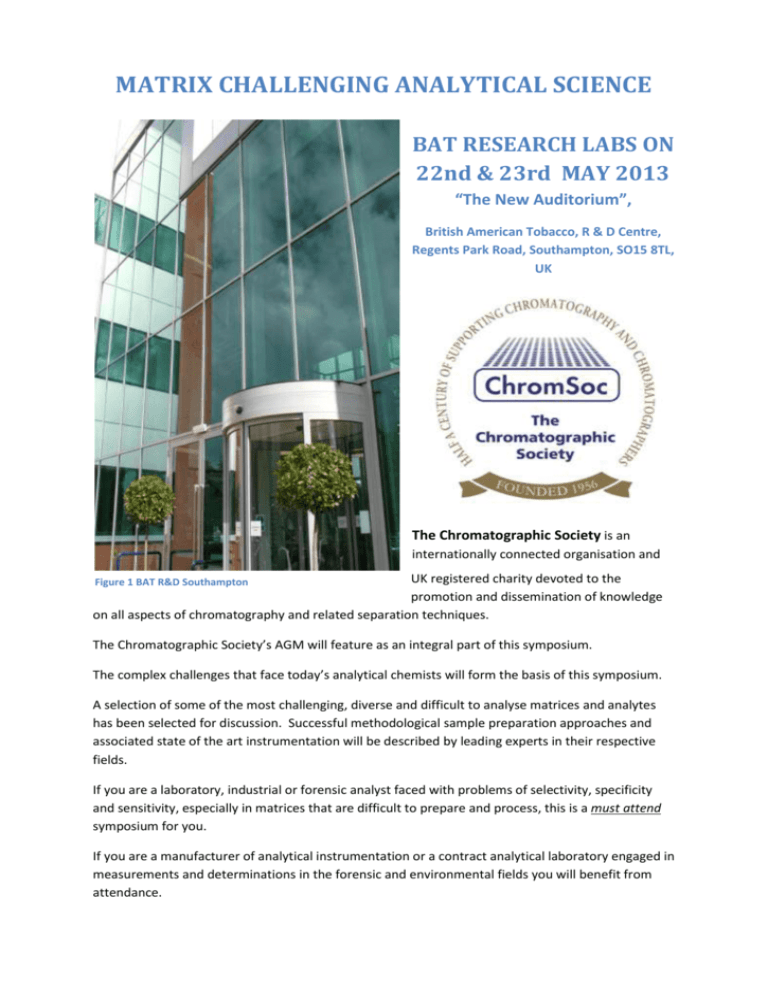
MATRIX CHALLENGING ANALYTICAL SCIENCE BAT RESEARCH LABS ON 22nd & 23rd MAY 2013 “The New Auditorium”, British American Tobacco, R & D Centre, Regents Park Road, Southampton, SO15 8TL, UK The Chromatographic Society is an internationally connected organisation and UK registered charity devoted to the promotion and dissemination of knowledge on all aspects of chromatography and related separation techniques. Figure 1 BAT R&D Southampton The Chromatographic Society’s AGM will feature as an integral part of this symposium. The complex challenges that face today’s analytical chemists will form the basis of this symposium. A selection of some of the most challenging, diverse and difficult to analyse matrices and analytes has been selected for discussion. Successful methodological sample preparation approaches and associated state of the art instrumentation will be described by leading experts in their respective fields. If you are a laboratory, industrial or forensic analyst faced with problems of selectivity, specificity and sensitivity, especially in matrices that are difficult to prepare and process, this is a must attend symposium for you. If you are a manufacturer of analytical instrumentation or a contract analytical laboratory engaged in measurements and determinations in the forensic and environmental fields you will benefit from attendance. Our Special Guest Speakers will include: Prof. Dr. Ralf Zimmermann, Head of the “Joint Mass Spectrometry Centre“ – JMSC @ University of Rostock and Helmholtz Zentrum München “On-line Monitoring of Complex Mixtures by Photoionisation Mass Spectrometry” Prof. Jean-François Focant, University of Liege, “Chasing away the smell of death: GCxGC-TOFMS characterization of cadaveric VOCs” Dr. Jasper van Heemst, BAT R&D labs Southampton, “Application of GC/HRToF for the identification and comparison of tobacco smoke constituents” Dr. Peter Clayton , BAT R&D labs, Southampton “Estimation of human smoke exposure by chromatographic analysis of spent cigarette filter extracts” Dr. Greg Johnson, Thermo Fisher Scientific “Developments in GCMS/MS to achieve increased efficiency and accuracy in the analysis of complex matrices” Figure 2 BAT analytical labs Brief Abstracts of Selected Presentations “Chasing away the smell of death” GCxGC-TOFMS characterisation of cadaveric VOCs J.F. Focant et al Soon after death, the decay process of mammalian soft tissues begins and leads to the release of hundreds of cadaveric VOCs into the surrounding environment. These decomposition products include the VOCs responsible for the odour of decomposition. Human remains detection (HRD) dogs utilize this odour signature to locate human remains. This presentation will illustrate recent advances in the characterization of human analogue decomposition VOCs using thermal desorption (TD) coupled to GCxGC, TOFMS. Decomposition headspace analyses of pig carcasses, grave soils, and HRD canine training solutions have been investigated It is believed these results could be of great value in forensic investigations. -------------------------------------------------------------------------------- “Application of GC/HRToF for the identification and comparison of tobacco smoke constituents” Jasper van Heemst et al Most extracts of plant-derived materials present analytical chemists with matrices that are particularly challenging to analyse. These extracts contain numerous compound classes with large variations in concentrations, solubility, reactivity, stability and other chemical and physical properties. Tobacco smoke is a very complex aerosol which contains over 5600 identified compounds. Part of this research is focussed on understanding the processes driving the formation of smoke constituents. This requires a non-targeted screening approach coupled with the capability to identify subtle differences in chemical profiles between samples. GC x GC - ToF approaches have been explored for the separation and identification of components in tobacco smoke and currently methods are being developed in which gas chromatography is coupled to high-resolution time-offlight mass spectrometry to enable comparison of chromatographic data from different tobacco smoke samples. “Estimation of human smoke exposure by chromatographic analysis of spent cigarette filters” Peter Clayton The presentation will explain the analytical measurements required to conduct the The Filter Analysis Method that allows the estimation of ‘tar’ and nicotine yields obtained by individual smokers. A particular emphasis of the presentation will be the estimation of the mouth-level exposure to tobacco-specific nitrosamines a number of which are categorised as priority toxicants in smoke. ============================================================================ Sponsoring & Exhibiting Companies currently include: TO DISCUSS YOUR SPONSORSHIP LEVEL AND/OR YOUR LECTURE CONTENT PLEASE CONTACT Dr. Chris Bevan at: chris.anne.bevan@gmail.com GOLD LEVEL SPONSORSHIP £1750 Table top exhibition stand & 20 mins lecture time integrated into the programme 3 free delegate admission places SILVER LEVEL SPONSORSHIP £1250 Table top exhibition stand & 10 mins lecture time integrated into the programme 2 free delegate admission places BRONZE LEVEL SPONSORSHIP £750 Table top exhibition stand and 1 free delegate admission place DELEGATE ADMISSION PRICES: CHROMATOGRAPHIC SOCIETY MEMBER = £ 250 NON-MEMBER RATE = £ 300 NOTE: MEMBERS OF THE BMSS OR THE RSC MAY APPLY AT CHROMSOC MEMBERS’ RATES NOTE: VAT at 20% is additionally charged on all prices TO REGISTER, BOOK YOUR EXHIBITION STAND AND SPONSORSHIP PLEASE CONTACT Matthew Gilmour , Senior Conference Executive ,Meeting Makers Block 4, Unit 4, Kelvin Campus, West of Scotland Science Park 2317 Maryhill Road, Glasgow, G20 0SP Tel: +44 (0) 141 945 6880 Fax: +44 (0) 141 945 6899 Email: matthew@meetingmakers.co.uk or chromsoc@meetingmakers.co.uk Registration fees include meals and refreshments supplied at the Symposium To encourage social networking between delegates, presenters and exhibitors an evening social event at the Sea City Museum, Southampton and a local inner-city pub quite close to the Museum will be organised. BAT will offer a lab tour and open their specialist historical exhibition attraction to all attendees during the symposium. Chromsoc bursaries are available for bona-fide students to assist them to attend this symposium.
